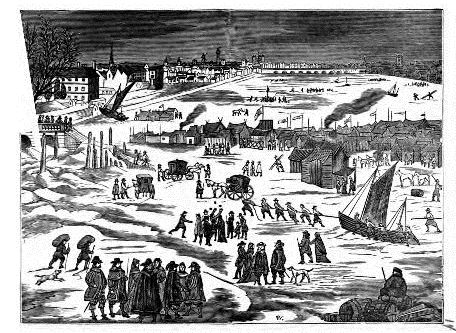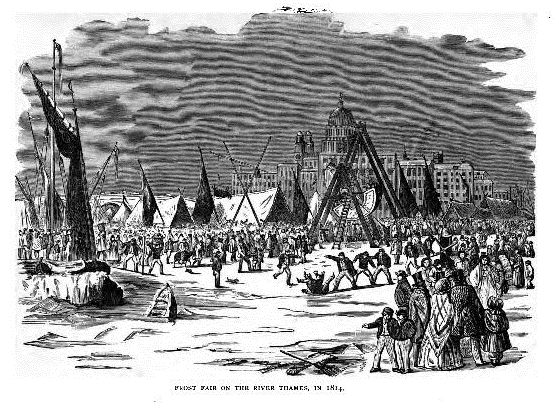The climate change deniers can stick their fingers
in their ears and go la-la-la all they wish but the climate of our
planet is changing and it is partly our fault. The climate alters over
time and overall temperatures fluctuate due to a number of factors that are
beyond our control but we certainly aren’t helping matters, although that’s a
subject for another time and place. One effect of temperature changes is a
cycle of ice ages and this includes the Little Ice Ages that happen during the
greater pattern. Opinions differ as to when the last Little Ice Age began and
ended but it affected northern Europe during the later Middle Ages and well
into the modern period.
 |
| Trouble on the Thames |
One consequence was that rivers and canals were frozen
on a regular basis, leading people to hold Frost Fairs on the ice, the most
famous being those on the river Thames at London. The earliest record we have
of the Thames freezing over is from 134 CE, when it froze for two months, in
153 many English rivers, including the Thames, froze over, and again in 173,
when the frost lasted for three months. In 220, there was a continuous frost
that lasted for five months, and in 250 the Thames was frozen for nine weeks.
Further severe winters followed on a regular basis – a frost began on November
1st 1076 and lasted until April 15th 1077
“In the tenth year of his [William the Conqueror] reign, the cold of winter was exceeding memorable, both for sharpness and for continuance; for the earth remained hard from the beginning of November until the midst of April then ensuing.”
A chronicle of 1092 notes,
“… the great streams [of England] were congealed in such a manner that they could draw two hundred horsemen and carriages over them; whilst at their thawing, many bridges, both of wood and stone, were borne down, and divers water-mills were broken up and carried away."
 |
| A Frost Fair |
There were more great frosts that followed, in 1564-65 Holinshed notes in his Chronicles,
“People went over and alongst the Thames on the ise, from London Bridge to Westminster. Some plaied at the football as boldlie there, as if it had been on the drie land ; divers of the court being then at Westminster, shot dailie at prickes set upon the Thames; and the people, both men and women, went on the Thames in greater numbers than in anie street of the Citie of London.”
The
Thames froze solid again in 1608, when the first Frost Fair was held on the ice
when, in addition to playing sports on the river, booths were erected and
stallholders sold ale, wine and food, together with fruit-sellers, shoemakers and
even a barber.
 |
| The Frost Fair on the Thames 1683-84 |
Another Fair followed in 1684, and was described by John Evelyn
in his Diary,
“Coaches plied from Westminster to the Temple, and from several other stairs to and fro, as in the streets, sleds, sliding with skates, a bull-baiting, horse and coach-races, puppet-plays and interludes, cooks, tippling, and other lewd places, so that it seemed to be a bacchanalian triumph, or carnival on the water.”
Evelyn also notes that an enterprising
printer named Croom set up his press on the ice and sold souvenir tickets
printed with the buyer’s name at sixpence a time, earning him in excess of £5
per day, in addition to his regular income from printed ballads and broadsheets
describing the daily trials and executions at Newgate Gaol.
 |
| One of Croom's souvenir tickets |
King Charles II and
his royal party visited the Frost Fair and had a souvenir ticket printed on
Dutch paper, measuring three and a half inches by four inches, listing their
names and concluding with the interesting line ‘Hans in Kelder’, which
is Dutch for ‘Jack in the Cellar’, indicating that Princess Anne was
pregnant at the time (she delivered a stillborn daughter on May 12th
1684); the phrase was used proverbially at the time to describe pregnancy and
did not hint at the sex of the child.
 |
| King Charles II - Croom ticket |
In spite of the jollity and merriment of
the Frost Fair, Evelyn marks the disastrous effects the freeze had on, not just
London, but the rest of England and even as far south as Spain. Trees froze and
were split as if by lightning, the frozen seas and rivers meant ships could not
get either in nor out, water, beer and wine froze solid and was sold by weight,
and men and beasts died from the cold. There were severe food and fuel
shortages and widespread starvation across the country.
 |
| London's Wonder - Ballad celebrating the 1684 thaw |
The Frost Fairs came to
be known as Blanket Fairs, after the blankets used to make the booths and
tents, and more Blanket Fairs followed whenever the Thames froze over. In
1739-40, the fair was held and a company of vintners bought an ox at Smithfield
market, which was taken out onto the ice, slaughtered and then roasted on a
spit. A fruit-seller, Doll the Pippin Woman, fell through the ice and was
drowned and the fair ended in confusion when the thaw came suddenly and
unexpectedly, bearing stalls, huts and shops away.
 |
| The Frost Fair of 1814 |
The last Frost Fair was held
in 1813-14, when severe ice built up in the river and finally froze into a mass
and the usual shops were erected in what was called City Road. There were
swings, skittles, sausage-sellers, singing, printers and book-sellers, and a
sheep was roasted whole and sold as ‘Lapland Mutton’ at a shilling a
slice. On February 5th the ice began to split and break apart and
the shops and presses went into the water, as did several unsuspecting persons,
several of whom were drowned.
 |
| The Frost Fair on the Thames 1716 |
This was the final Frost Fair held on the frozen
river, as old London Bridge was replaced in 1831, with wider arches that did
not encourage the build-up of ice floes, the banks of the river had several
embankments built upon them, increasing the speed and depth of the water and
the climate began to warm, making it less likely for the Thames to freeze
solid.
No comments:
Post a Comment